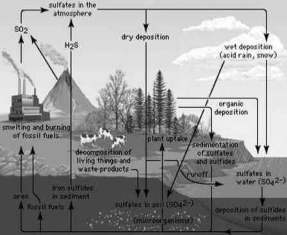2.7.3. Sedimentary Cycle
Phosphorus, calcium and magnesium circulate by means of the sedimentary cycle. The element involved in the sedimentary cycle normally does not cycle through the atmosphere but follows a basic pattern of flow through erosion, sedimentation, mountain building, volcanic activity and biological transport through the excreta of marine birds.
(a) Phosphorus Cycle
Phosphorus plays a central role in aquatic ecosystems and water quality. Unlike carbon and nitrogen, which come primarily from the atmosphere, phosphorus occurs in large amounts as a mineral in phosphate rocks and enters the cycle from erosion and mining activities. This is the nutrient considered to be the main cause of excessive growth of rooted and free-floating microscopic plants in lakes.

Phosphorous cycle
The main storage for phosphorus is in the earth’s crust. On land phosphorus is usually found in the form of phosphates. By the process of weathering and erosion phosphates enter rivers and streams that transport them to the ocean.
In the ocean once the phosphorus accumulates on continental shelves in the form of insoluble deposits. After millions of years, the crustal plates rise from the sea floor and expose the phosphates on land. After more time, weathering will release them from rock and the cycle’s geochemical phase begins again.
(b) Sulphur Cycle
The sulphur reservoir is in the soil and sediments where it is locked in organic (coal, oil and peat) and inorganic deposits (pyrite rock and sulphur rock) in the form of sulphates, sulphides and organic sulphur.
It is released by weathering of rocks, erosional runoff and decomposition of organic matter and is carried to terrestrial and aquatic ecosystems in salt solution.
The sulphur cycle is mostly sedimentary except two of its compounds hydrogen sulphide (H2S) and sulphur dioxide (SO2) add a gaseous component to its normal sedimentary cycle.
Sulphur enters the atmosphere from several sources like volcanic eruptions, combustion of fossil fuels, from surface of ocean and from gases released by decomposition. Atmospheric hydrogen sulphide also gets oxidised into sulphur dioxide. Atmospheric sulphur dioxide is carried back to the earth after being dissolved in rainwater as weak sulphuric acid.

Sulphur Cycle
Whatever the source, sulphur in the form of sulphates is take up by plants and incorporated through a series of metabolic processes into sulphur bearing amino acid which is incorporated in the proteins of autotroph tissues. It then passes through the grazing food chain.
Sulphur bound in living organism is carried back to the soil, to the bottom of ponds and lakes and seas through excretion and decomposition of dead organic material.
The Bio-geochemical cycles discussed here are only a few of the many cycles present in the ecosystem. These cycles usually do not operate independently but interact with each other at some point or the other.
Do you know?
Fur-picking’, the universal habit among the apes and monkeys is not a hunt for lice or fleas. They are naturally remarkably free from these vermin. On the contrary it is a means of social communication between members of the troop (a group of monkeys) and to develop strong social bond.
